Clash of the Titans - TT Tai Chi vs. CM Stacker 830
by Joshua Buss on February 23, 2006 12:05 AM EST- Posted in
- Cases/Cooling/PSUs
Thermaltake Tai Chi
Thermaltake knows how to make a good case. This has been shown to be true time and time again both by our site and many others. A subdivision of theirs, Thermalrock, ran away with a gold editor's choice award in our large 8-way comparison for its excellent Eclipse case, and although never published, a close examination of their Armor case also bore out this claim as it is a fine unit capable of just about anything that one could ever want in a computer case. So, how does one improve upon cases as nice as the Armor and Eclipse, exactly? Well for starters, you don't remove any of the features that made the predecessors so popular.
Like the armor, the most prominent feature of the Tai Chi is the staggering number of externally available 5¼” drive bays – 11 to be exact. While there is one bay that's already assumed used for the 3½” drive/ power+reset buttons/LED indicators unit, it's still technically optional, as is the accessory tray and hard drive cage. Even with all three of these units in place, however, the Tai Chi could hold any of the following possible configurations: an additional six 5¼” drives; three 5¼” drives and an additional three hard drives; or two more hard drive cages for a total of nine hard drives. The storage options alone will be reason enough for some people to jump right on this unit. With this much capacity comes a price – and that price is size. The Tai Chi is massive.
Getting past the amazing drive capacity and size is just the beginning, however; the Thermaltake flagship case doesn't look like a giant radiator for nothing. Solid 1/8” think aluminum panels lining both sides absorb much of the computer's excess heat and passively vent it to the surrounding air.
The right side of the case, being almost entirely void of anything interesting, is even more monolithic in appearance than the left. To break up the monotony and give the case its own flair, Thermaltake uses two overlapping flaps to conceal the front drives.
The inner flap is anodized black, and when partially covered by the silver flap, helps to spice up the otherwise all-silver look and give the case a very stylish curved theme when viewed from the front. Besides simply looking cool, these over-sized half-doors should provide some decent protection considering their thickness, something that we questioned with the Armor's “flaps”. In addition to beefy door panels, the Tai Chi comes with two solid aluminum handles to help move the beast around, which are not even really optional anymore on a case this size. Nonetheless, they are a well-executed addition, and are completely removable if desired.
Here, we can take a closer look at the actual finish of the Tai Chi and the layout of the top of the unit. Notice how the paint job actually leaves the aluminum with a metallic speckled look. The pictures don't even really do it justice, as it almost comes across as a brilliant platinum more so than a normal silver anodization. The port cluster for the Tai Chi is on top, and unfortunately, it places all the ports very close to each other, but that's starting to become less and less of a problem as USB devices continue to shrink. With the USB, FireWire, and audio jacks so far back on the top of the unit, Thermaltake was locking themselves into users placing this case on the ground, but with a case this large, we don't think that many users would object to this restraint – this case would simply look out of place on top of most desks.
The left side of the Tai Chi is all business. Massive holes open the warmest area of the interior completely to the outside, while large aluminum fins do the rest of the work in terms of whisking away heat from the computer. The various visible screws are what hold the three individual panels in place, but can be taken out if work needs to be done on any panel.
Thermaltake knows how to make a good case. This has been shown to be true time and time again both by our site and many others. A subdivision of theirs, Thermalrock, ran away with a gold editor's choice award in our large 8-way comparison for its excellent Eclipse case, and although never published, a close examination of their Armor case also bore out this claim as it is a fine unit capable of just about anything that one could ever want in a computer case. So, how does one improve upon cases as nice as the Armor and Eclipse, exactly? Well for starters, you don't remove any of the features that made the predecessors so popular.
Like the armor, the most prominent feature of the Tai Chi is the staggering number of externally available 5¼” drive bays – 11 to be exact. While there is one bay that's already assumed used for the 3½” drive/ power+reset buttons/LED indicators unit, it's still technically optional, as is the accessory tray and hard drive cage. Even with all three of these units in place, however, the Tai Chi could hold any of the following possible configurations: an additional six 5¼” drives; three 5¼” drives and an additional three hard drives; or two more hard drive cages for a total of nine hard drives. The storage options alone will be reason enough for some people to jump right on this unit. With this much capacity comes a price – and that price is size. The Tai Chi is massive.
Getting past the amazing drive capacity and size is just the beginning, however; the Thermaltake flagship case doesn't look like a giant radiator for nothing. Solid 1/8” think aluminum panels lining both sides absorb much of the computer's excess heat and passively vent it to the surrounding air.
The right side of the case, being almost entirely void of anything interesting, is even more monolithic in appearance than the left. To break up the monotony and give the case its own flair, Thermaltake uses two overlapping flaps to conceal the front drives.
The inner flap is anodized black, and when partially covered by the silver flap, helps to spice up the otherwise all-silver look and give the case a very stylish curved theme when viewed from the front. Besides simply looking cool, these over-sized half-doors should provide some decent protection considering their thickness, something that we questioned with the Armor's “flaps”. In addition to beefy door panels, the Tai Chi comes with two solid aluminum handles to help move the beast around, which are not even really optional anymore on a case this size. Nonetheless, they are a well-executed addition, and are completely removable if desired.
Here, we can take a closer look at the actual finish of the Tai Chi and the layout of the top of the unit. Notice how the paint job actually leaves the aluminum with a metallic speckled look. The pictures don't even really do it justice, as it almost comes across as a brilliant platinum more so than a normal silver anodization. The port cluster for the Tai Chi is on top, and unfortunately, it places all the ports very close to each other, but that's starting to become less and less of a problem as USB devices continue to shrink. With the USB, FireWire, and audio jacks so far back on the top of the unit, Thermaltake was locking themselves into users placing this case on the ground, but with a case this large, we don't think that many users would object to this restraint – this case would simply look out of place on top of most desks.
The left side of the Tai Chi is all business. Massive holes open the warmest area of the interior completely to the outside, while large aluminum fins do the rest of the work in terms of whisking away heat from the computer. The various visible screws are what hold the three individual panels in place, but can be taken out if work needs to be done on any panel.


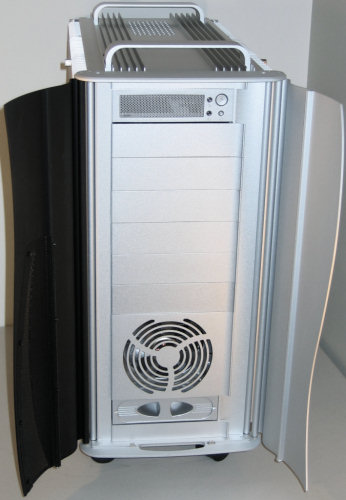
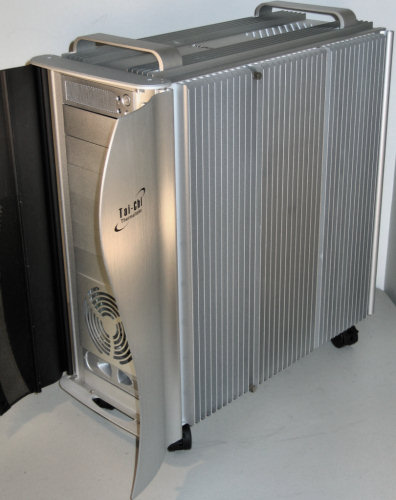
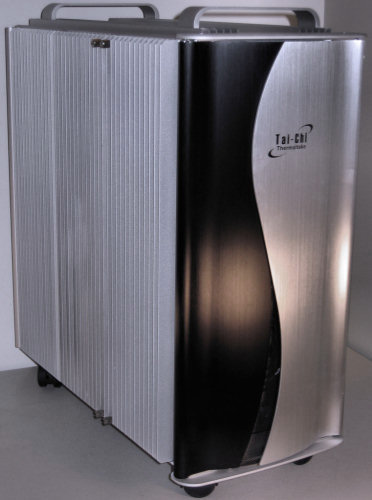
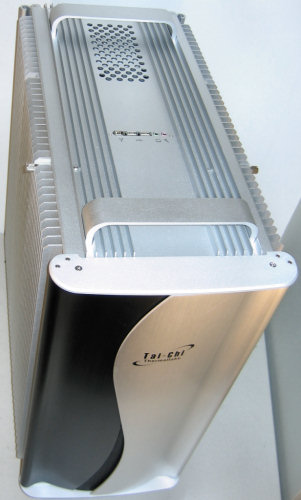
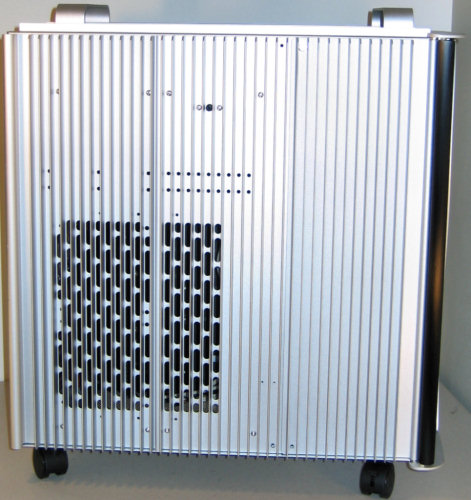








55 Comments
View All Comments
BubbaJudge - Thursday, February 23, 2006 - link
I was wafting between the Tai Chi and the Koolance PC3-725BK based on the Lian Li PC-V1000, it would have been great to include both watercooled versions for review, but great review regardless. I think I will go with the Koolance, as I agree the Tai Chi looks a little heat sink gimmicky. Hopefully I can stuff a PC P&C 850 in the Lian Li chassis.chynn - Thursday, March 2, 2006 - link
The PCP@C 850W might not fit in the Lian-Li V1000 case; however, it will definitely fit in the Lian-Li V1200 case. I have the latter Lian-Li case but will be replacing it with RC-830 Stacker case ... the RC-830 case is just that much better.mkruer - Thursday, February 23, 2006 - link
Call me old fashion but I like the simple designRip the Jacker - Thursday, February 23, 2006 - link
first.tuteja1986 - Thursday, February 23, 2006 - link
I am buying Cool Master Stacker now :) . its an awesome case and goes arround $200AUD in Australia. I am going to use 2 PSU 480W antec and 550W antec. Go full crossfire when i sell my Asus A8N SLI-32 and buy either a RD580 mobo from ABit or ASUS or DFI.